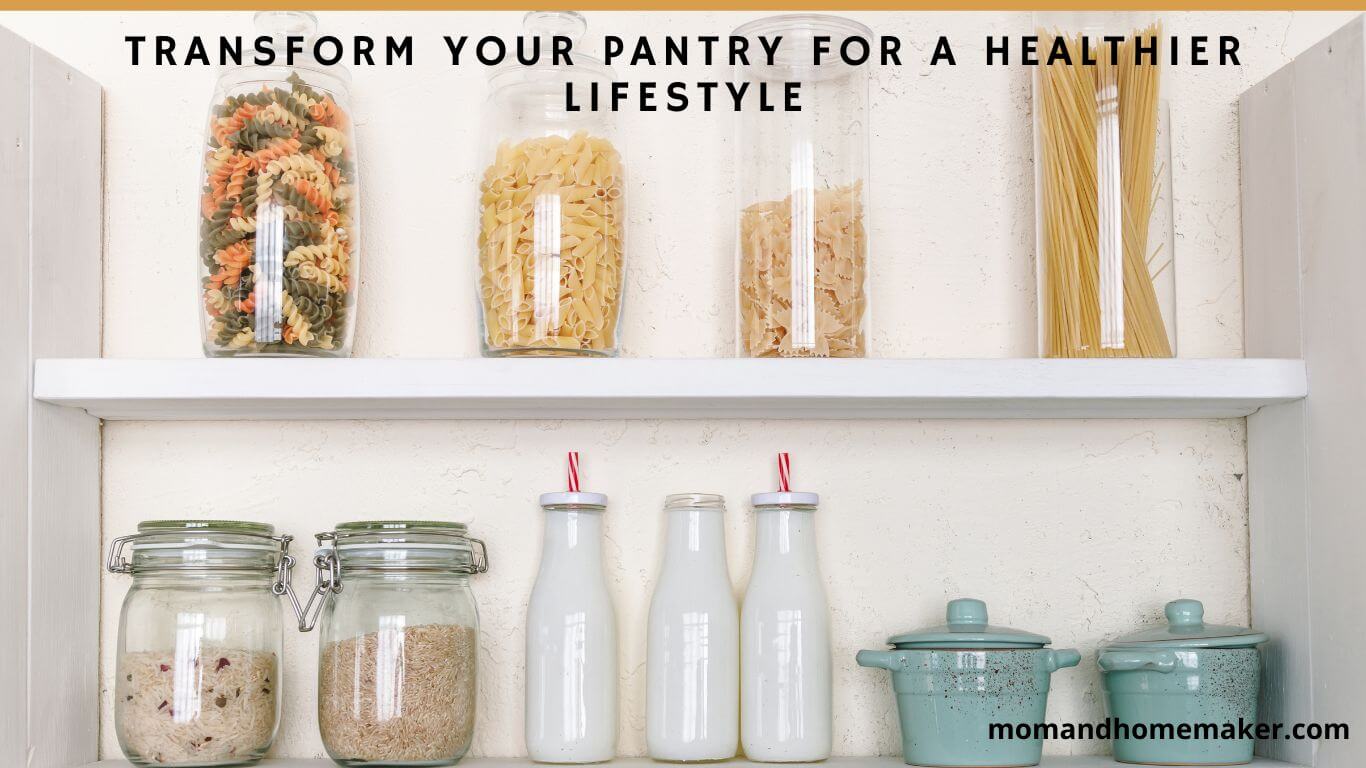Transforming your pantry to support a healthier lifestyle is simpler than you might think. By making small changes to the foods you keep stocked, you can greatly enhance your overall well-being.
For instance, instead of opting for sugary cereals in the morning, go for whole grains like oatmeal or whole wheat bread. By removing unhealthy processed foods and incorporating more nutritious options such as legumes and alternative dairy products, you can make a significant impact on your diet.
These steps will help you create a pantry that aligns with your health goals and facilitates wholesome choices.
Let’s embark on this journey to transform your pantry and ultimately transform your life.

Assess Your Current Pantry Setup
To start the process of transforming your pantry for a healthier lifestyle, it’s essential to assess its current setup. The first step is to take inventory of what you have. Go through each shelf and make note of the items, paying attention to expiration dates and any unhealthy products that need to be replaced.
Once you have a clear idea of your current stock, you can determine your nutritional needs. Consider your dietary goals and any specific restrictions you may have.
Next, evaluate the storage space in your pantry. Are there any areas that are underutilized or overcrowded? Make sure you have enough room for the healthier options you plan to add.
With all this information in mind, you can create a meal plan that aligns with your nutritional needs and goals. This will help you make healthier choices and avoid impulse buys at the grocery store.
Finally, research pantry organization tips to maximize the space and make it easier to find and access the items you need. By taking these steps, you can set yourself up for success in creating a healthier pantry.
Remove Unhealthy Processed Foods
I will declutter my pantry by removing any unhealthy processed foods. This simple action will help me create a healthier and more balanced pantry. To begin, I’ll search for nutritious snack alternatives to replace the processed snacks that used to occupy my shelves. Options like fresh fruits, nuts, or homemade energy bars can be excellent substitutes.
There are numerous benefits to eliminating processed foods from my pantry. Firstly, these foods often contain excessive amounts of added sugars, unhealthy fats, and artificial ingredients. By removing them, I can reduce my intake of these harmful substances and significantly improve my overall health. Processed foods tend to be low in nutrients but high in calories, which can contribute to weight gain and other health problems.
Creating a balanced pantry involves incorporating a variety of whole foods that provide essential nutrients. This includes including fruits, vegetables, whole grains, lean proteins, and healthy fats. By prioritizing whole foods, I can ensure that my pantry is stocked with nourishing options that support my overall well-being.
Transitioning to a pantry filled with whole foods may require some time and effort, but the benefits are undoubtedly worth it. Whole foods are naturally rich in vitamins, minerals, and antioxidants that promote good health and reduce the risk of chronic diseases. By making this positive change, I’m taking a significant step towards a healthier lifestyle.
Stock up on Whole Grains
Incorporating whole grains into your pantry can greatly contribute to a healthier lifestyle.
Whole grains, such as quinoa, and brown rice, and whole wheat alternatives like pasta and bread, barley, and oatmeal, offer a plethora of health benefits.
Quinoa, for example, is a versatile grain that provides complete protein, fiber, vitamins, and minerals. It also has a low glycemic index, making it an excellent choice for managing blood sugar levels.
Brown rice, on the other hand, is packed with fiber, magnesium, and essential nutrients, and can be used in a variety of dishes.
Whole wheat alternatives like pasta and bread retain more nutrients and fiber compared to refined options.
Barley, often overlooked, offers a nutty flavor and high fiber content, making it a great choice for soups and stews.
Lastly, oatmeal, available in various forms, is a filling breakfast option that can help regulate cholesterol levels and improve heart health.
Incorporate a Variety of Legumes
Incorporating a variety of legumes into my pantry is a crucial step towards a healthier lifestyle. Legumes, like lentils, chickpeas, and black beans, are not only delicious but also offer numerous health benefits.
They are an excellent source of plant-based protein, making them a great choice for individuals following a vegetarian or vegan diet. Legumes are also low in fat and high in fiber, which aids in weight management and promotes digestive health.
Legumes have been shown to positively impact heart health. They contain high levels of soluble fiber, which can help lower cholesterol levels and reduce the risk of heart disease. Including legumes in my diet can also assist in regulating blood sugar levels, making them a valuable addition for individuals with diabetes.
To make it easier for you to incorporate legumes into your pantry, here is a table with some legume options along with their benefits and a suggested recipe:
| Legume | Benefits | Recipe Suggestion |
|---|---|---|
| Lentils | High in protein | Lentil Curry |
| Chickpeas | Heart-healthy | Hummus |
| Black beans | Fiber-rich | Black Bean Salad |
Opt for Healthier Cooking Oils
Choosing healthier cooking oils is an important step toward improving your overall well-being. Not only do they offer numerous benefits, such as reducing the risk of heart disease and improving digestion, but they also play a crucial role in maintaining healthy cholesterol levels.
When selecting a cooking oil, it’s essential to consider its smoke point—the temperature at which it starts to break down and release harmful substances. For high-heat cooking methods like frying or sautéing, opt for oils with a high smoke point, such as avocado oil or refined coconut oil. These oils are more stable and less likely to oxidize, preserving their nutritional value.
On the other hand, for low-heat cooking or salad dressings, extra virgin olive oil or flaxseed oil are excellent choices. They contain heart-healthy monounsaturated fats and omega-3 fatty acids.
It’s important to be aware of the health impact of unhealthy cooking oils, like vegetable oils high in omega-6 fatty acids, which can be pro-inflammatory and contribute to chronic diseases.
Choose Natural Sweeteners
When it comes to cooking and maintaining a well-stocked pantry, it’s important to consider the sweeteners you use. Natural sweeteners are excellent alternatives to sugar that not only add sweetness to your dishes but also offer various health benefits. These sweeteners can be used as substitutes in baking and can help reduce your sugar intake.
One popular natural sweetener is honey, which is packed with antioxidants and has antibacterial properties. It imparts a unique flavor to your recipes and can be used in both sweet and savory dishes.
Another option is maple syrup, derived from the sap of maple trees. It contains essential minerals like calcium and potassium, making it a healthier choice compared to refined sugar.
Stevia, a plant-based sweetener, is significantly sweeter than sugar, so you only need a small amount. It has zero calories and doesn’t raise blood sugar levels, making it suitable for diabetics.
Coconut sugar is another natural sweetener worth considering. It’s made from the sap of coconut palm trees and has a lower glycemic index than regular sugar. Additionally, it contains vitamins and minerals.
By opting for natural sweeteners, you can enjoy the sweetness in your dishes while reaping their health benefits. So, the next time you’re baking or preparing a sweet treat, consider using these sugar alternatives to make your pantry a healthier place.
Organize Your Pantry for Easy Access
To make your pantry more organized and easily accessible, one effective method is to create labeled storage bins. These pantry organization hacks can greatly simplify the task of finding what you need promptly.
Having a well-organized pantry not only saves time but also contributes to a healthier lifestyle. By keeping everything in its proper place, you can easily identify which pantry essentials you have and what items need to be restocked.
Here are some simple yet effective tips to achieve an organized pantry. Start by decluttering your pantry, removing expired items, and donating anything you won’t use.
Next, group similar items together, such as baking supplies or canned goods, and store them in separate labeled bins. This way, you can easily locate the items you need without having to search through shelves.
Maintaining an organized pantry offers several benefits. It helps reduce food waste by enabling you to see what you have and use ingredients before they expire. It facilitates meal planning and grocery shopping, as you can quickly assess what items you need to purchase.
To keep your pantry organized, make it a habit to regularly check expiration dates and rotate items accordingly. Keep things tidy by wiping down shelves and promptly cleaning up any spills. By following these straightforward steps, you can transform your pantry into a functional and efficient space that supports your healthy lifestyle.
Label Containers for Clarity
Labeling containers is a crucial step in achieving a clear and organized pantry. A good labeling system ensures clear communication and easy identification of items, making it simple to find what you need and maintain an organized space.
Here are some tips to help you create an effective labeling system:
- Use clear and legible labels: It’s important to use permanent markers or a label maker to write the names of the contents on each container. This ensures easy identification and prevents confusion.
- Invest in a label maker: Consider investing in a label maker to take your organization to the next level. These devices provide professional-looking labels that are easy to read and allow you to customize the font style and size according to your preferences.
- Consider color-coding: Color-coding is an effective strategy for labeling containers. Assign different colors to different food groups or categories, such as grains, canned goods, and snacks. This visual cue makes it even easier to find what you’re looking for, especially when you’re in a hurry.
Prioritize Fresh Fruits and Vegetables
To create a healthier pantry, I prioritize fresh fruits and vegetables. Adding these nutrient-rich foods to my diet has many benefits. Fresh fruits are packed with vitamins, minerals, and antioxidants that support overall health. They also provide a healthier alternative to processed sweets as they contain natural sugars.
Vegetables, on the other hand, offer a wide range of nutrients like fiber, vitamins, and minerals. They can be the star of many nutritious and delicious dishes. When it comes to including fresh produce in my meals, I enjoy trying out different vegetable recipes. From roasted Brussels sprouts to zucchini noodles, there are countless ways to make vegetables the highlight of any meal.
To make the most of the seasonal produce, I refer to a seasonal produce guide that helps me choose the freshest and most flavorful options. This not only ensures optimal taste but also supports local farmers and reduces my carbon footprint.
When purchasing fresh fruits and vegetables, I try to prioritize organic options whenever possible. While organic produce may be more expensive, it’s free from harmful pesticides and synthetic fertilizers.
However, I understand that organic options may not always be accessible or affordable for everyone. In such cases, I opt for conventional produce and make sure to wash them thoroughly before consuming.
One of my favorite places to find fresh produce is the local farmers market. Not only do I get to support local farmers, but I also have the opportunity to connect with the community and learn more about the food I’m buying. To make the most of my farmers’ market visits, I go with a shopping list, arrive early for the best selection, and ask the farmers for tips and recommendations.
Include a Selection of Nutritious Nuts and Seeds
Including a variety of nutritious nuts and seeds is an essential step in transforming your pantry for a healthier lifestyle. Nuts and seeds are packed with vital nutrients and offer numerous health benefits.
They are rich sources of healthy fats, protein, fiber, vitamins, and minerals. By incorporating nuts and seeds into your diet, you can lower the risk of heart disease, improve brain function, support weight management, and enhance overall well-being.
To highlight the importance of including nuts and seeds in your pantry, let’s take a look at a table showcasing various options and their nutritional profiles:
| Nut/Seed | Nutritional Benefits | Delicious Ways to Incorporate |
|---|---|---|
| Almonds | High in vitamin E and magnesium | Add to salads or trail mix |
| Chia Seeds | Excellent source of omega-3 fatty acids and fiber | Use in smoothies or puddings |
| Pumpkin Seeds | Rich in iron, zinc, and antioxidants | Sprinkle on soups or yogurt |
| Flaxseeds | High in omega-3 fatty acids and lignans | Mix into baking recipes |
Exploring different varieties of nuts and seeds allows for a diverse range of flavors and nutritional benefits. From almonds to chia seeds, each option offers unique advantages that contribute to a healthy lifestyle. By incorporating these nutrient-rich nuts and seeds into your diet, you can transform your pantry and reap the many benefits they provide.
Spice up Your Pantry With Herbs and Spices
I enjoy adding a variety of herbs and spices to my pantry. Not only do they bring amazing flavors to my dishes, but they also have numerous health benefits. From using herbs for common ailments to making my spice blends, there are endless possibilities to explore.
One of the things I love is discovering the unique taste and aroma of different herbs and spices. Each one has its distinct flavor profile that can take any dish to new heights. I enjoy learning about the health benefits associated with various herbs and spices.
For example, turmeric is known for its anti-inflammatory properties, while cinnamon helps regulate blood sugar levels.
Incorporating herbs and spices into my daily cooking routine has become second nature. Instead of relying on salt and unhealthy seasonings, I choose natural and flavorful alternatives. This not only enhances the taste of my meals but also contributes to a healthier lifestyle.
Another enjoyable aspect is creating my spice blends. It allows me to customize the flavors and experiment with different combinations. It’s remarkable how a simple blend of herbs and spices can transform an ordinary dish into something extraordinary.
Consider Alternative Dairy and Plant-Based Milk Options
As I explore ways to make my pantry healthier, I’m excited to learn about alternative dairy and plant-based milk options. One of the reasons why I want to explore these options is because plant-based milk offers nutritional benefits.
Unlike traditional dairy milk, plant-based milk is often fortified with essential vitamins and minerals like calcium and vitamin D. This makes it a great choice for people who are lactose intolerant or have dairy allergies.
When it comes to taste, there are various plant-based milk options available, such as almond, soy, oat, and coconut milk. Each option has its unique flavor, so it’s important to try different ones to find the taste that suits you best.
When choosing alternative dairy products, it’s important to consider your health. Look for products that have minimal additives and are low in added sugars.
Incorporating plant-based milk into everyday recipes is easier than you might think. You can use it as a substitute for dairy milk in smoothies, cereal, baking, and even savory dishes like soups and sauces. Experimenting with different recipes can help you discover new and delicious ways to include plant-based milk in your diet.
Don’t Forget About Healthy Snacks
It’s important to regularly include healthy snacks in my pantry for a balanced and nourishing lifestyle. Snacking can help keep hunger at bay and provide an energy boost throughout the day. When choosing snacks, I prefer options that are quick and easy to prepare and that offer nutritional benefits.
Here are some healthy snack ideas that I enjoy:
- Greek Yogurt with Fruit: This snack is high in protein and calcium, which are essential for a healthy diet. Instead of sugary yogurts, I recommend swapping them for plain Greek yogurt and adding fresh fruit for natural sweetness.
- Raw Nuts and Seeds: These snacks are rich in healthy fats and fiber, which are important for overall well-being. To reduce sodium intake, I suggest swapping salted nuts for unsalted varieties.
- Veggie Sticks with Hummus: This snack is packed with vitamins and minerals that support good health. As an alternative to chips and dip, try sliced veggies with hummus for a healthier option.
By incorporating healthy snacks into my meal planning, I can avoid reaching for unhealthy options when hunger strikes. It’s important to have a variety of snacks readily available in my pantry, such as nuts, seeds, fresh fruits, and cut-up vegetables. With these nutritious options on hand, I can easily satisfy cravings without resorting to processed and sugary treats.
Making these simple swaps and embracing easy snack ideas allows me to maintain a healthy lifestyle.
Remember, a well-balanced diet is key to overall health and wellness. So, don’t forget to stock up on healthy snacks to support your journey towards a nourishing lifestyle.
Utilize Storage Solutions to Maximize Space
Maximizing the space in your pantry can be easily achieved by using smart storage solutions. It’s important to optimize efficiency and make the most of the available space. By incorporating space-saving solutions, you can create a well-organized and functional pantry.
One effective way to maximize space is by utilizing creative organization techniques. You can make use of adjustable shelves to fully utilize the vertical space in your pantry.
Another idea is to install hooks or racks on the inside of the pantry door, allowing you to hang items like measuring cups or small utensils. Investing in stackable containers or bins can help you store smaller items such as snacks or spices.
To further enhance your pantry’s efficiency, consider using clear containers or jars for storing dry goods. This allows you to easily see what you have and prevents food from going to waste. Labeling these containers can also contribute to keeping everything organized and easily accessible.
Incorporating pull-out drawers or rotating shelves can greatly facilitate access to items stored at the back of your pantry. By utilizing these storage solutions, you can ensure that nothing gets buried or forgotten, maximizing every inch of space.
In conclusion, maximizing space in your pantry requires creative organization and clever storage solutions. By implementing these strategies, you can optimize your pantry and create a functional and efficient space.
Establish a Regular Pantry Maintenance Routine
Maintaining an organized pantry is essential for a healthier lifestyle. By regularly checking and restocking your supplies, you can ensure that you have everything you need for meal preparation.
Start by cleaning out your pantry regularly to remove expired or unused items. This won’t only keep your pantry clean and fresh but also give you a clear view of what items you need to restock.
Meal planning is another important aspect of pantry maintenance. By planning your meals, you can save time and avoid last-minute trips to the store. Make sure to stock up on staple items such as grains, legumes, and canned goods to always have the basics for a nutritious meal.
Implementing a labeling system can also help you keep track of your pantry inventory. Use clear labels or transparent containers to easily identify ingredients and expiration dates.
Conclusion
Transforming your pantry for a healthier lifestyle is a straightforward but impactful step towards improving your overall well-being.
By eliminating processed foods and opting for whole grains, legumes, and healthier cooking oils, you can make positive changes to your diet.
It’s also important to consider alternative dairy and plant-based milk options, as well as incorporating healthy snacks.
With proper storage solutions and regular pantry maintenance, you’ll be well on your way to achieving a healthier you.

















